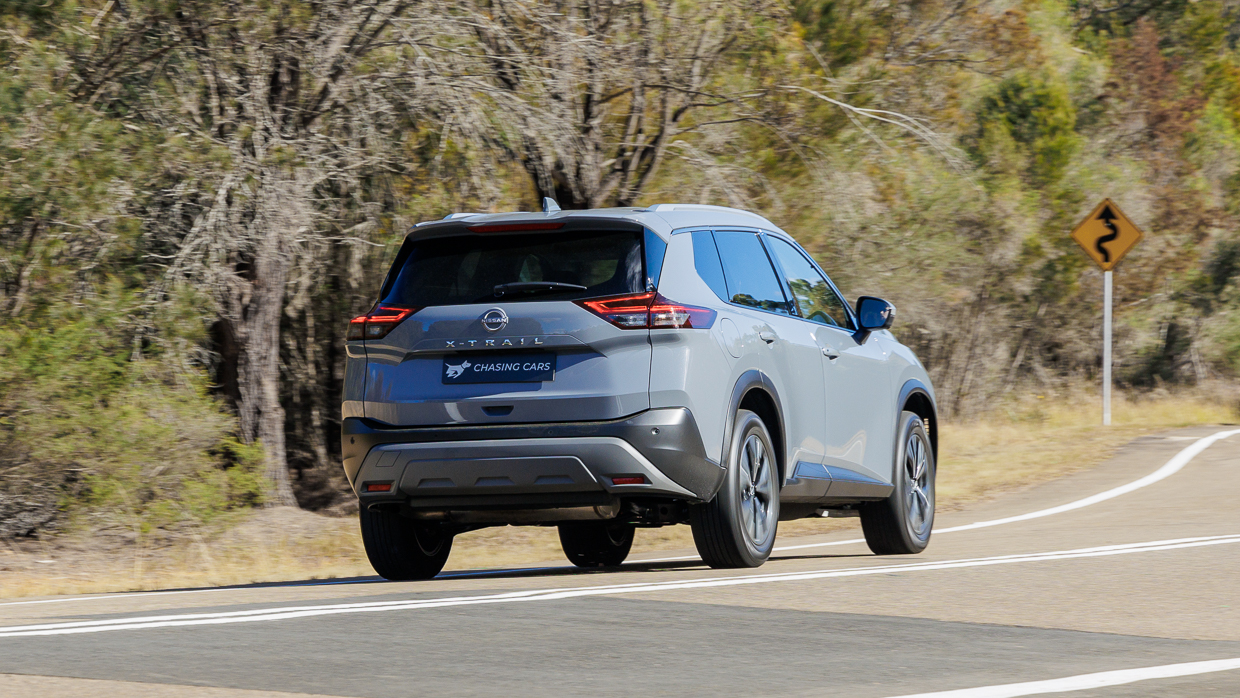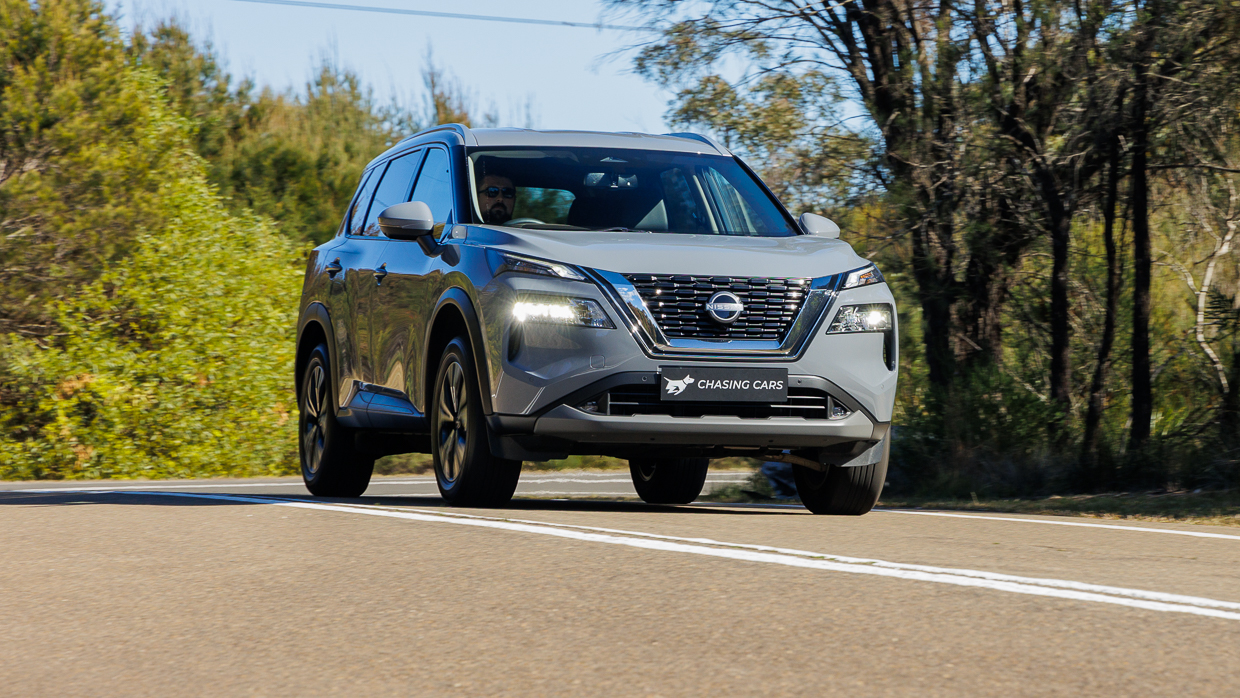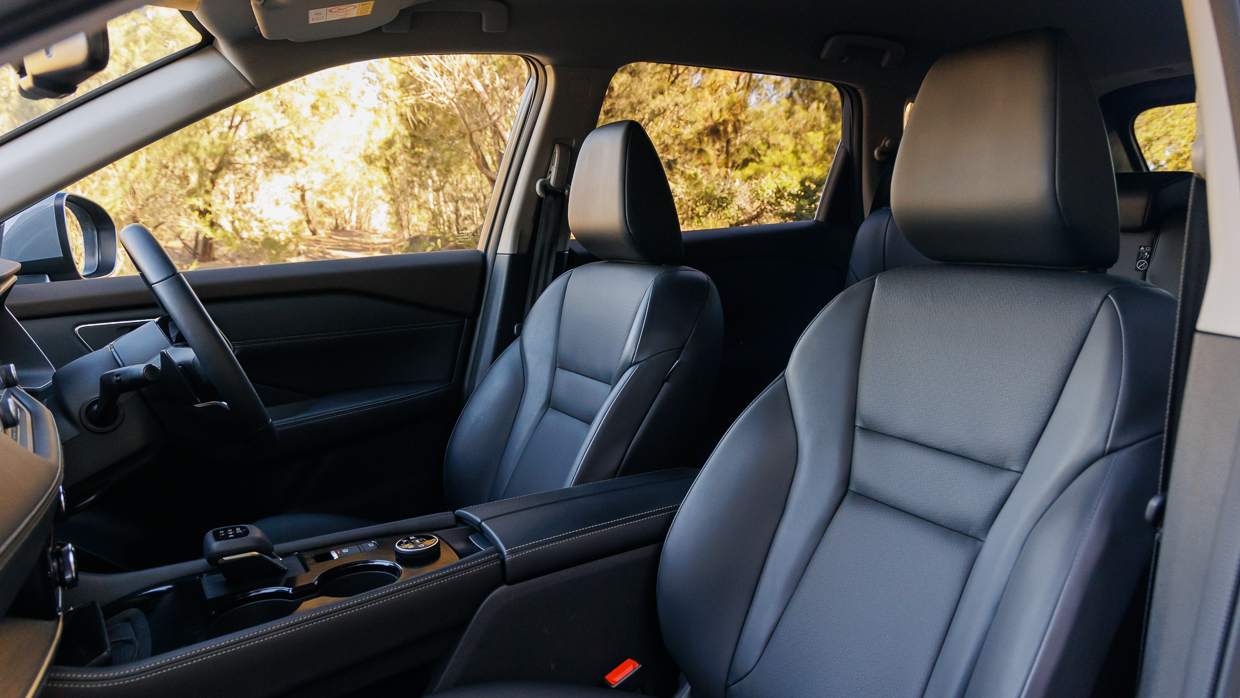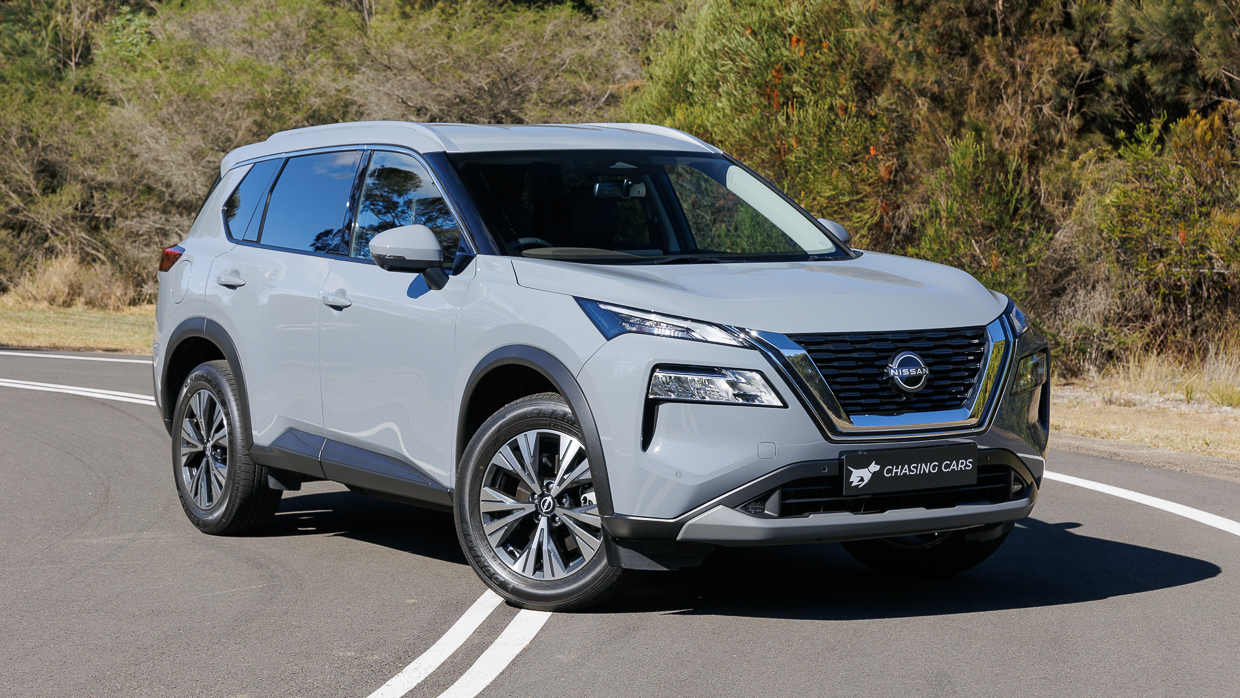-
Car Reviews
- All reviews
- Midsize SUVs
- Small cars
- Utes
- Small SUVs
- Large SUVs
- Large cars
- Sports SUVs
- Sports cars
- Vans
Latest reviews
- Car News
-
Car Comparisons
Latest comparisons
- Chasing Deals
With seven seats, all-wheel-drive and a general no-nonsense approach to everything, is this Nissan X-Trail a smart buy for families?
If you are a family in pursuit of more space on the move, the jump from a midsize SUV such as the Nissan X-Trail to a large SUV like the brand’s Pathfinder isn’t a move you should take lightly.
Immediately, the price of entry jumps around $17K in this pairing and you’re going to have to think about where and how you park, potentially higher fuel expenditure and the added cost of bigger tyres – the list really does go on.

Seven-seaters are rarely just purchased by those who need to seat – well – seven, either. At least not all the time. For many, it’s enough to have a vehicle that can stretch to accommodate extra passengers in a pinch.
Manufacturers have been cramming three-row seating into midsize vehicles like this X-Trail you see here for review for some time. Volkswagen even offers a stretched version of its relatively compact Tiguan – in the form of the Tiguan Allspace – to offer the space for seven.
Other options in the midsize segment include the Skoda Kodiaq and the X-Trail’s sibling, the Mitsubishi Outlander, along with value options such as the Mahindra XUV700.

The X-Trail however, is somewhat of a rising star in this segment and has left a strong impression on many in the Chasing Cars team due to its well-rounded capability and affordability in a segment where competition is fierce.
Deputy editor Curt Dupriez recently reviewed the five-seat X-Trail ST-L and was quite impressed if not quite enamoured by what it had to offer, dollar for dollar.
So does the value proposition make more sense when you make room for seven?
Nissan’s X-Trail range comprises the ST, ST-L, Ti and Ti-L, with the first two grades offered in a more affordable front-wheel-drive, five-seat variant. For an extra circa-$3000 however, buyers can add a third row – and gain the benefit of all-wheel-drive as a nice bonus.
It stands out as a pretty good deal for the relatively modest additional outlay, and with the addition of AWD you also get a few off-road drive modes to help you take full advantage of all-paw drive. For a full blow-by-blow on each grade, read our separate article.
Prices for the X-Trail range kick off at $37,250 before on-road costs but the ST-L AWD you see here is priced from $46,790.

Some of the standard features include:
I’m convinced the most revealing time to drive a car is first thing in the morning. Your wits aren’t at their sharpest, your mind is likely focused on plotting your day ahead and, for those with families, the cabin is filled with the tranquil sound of chatting, yelling and chaos.
Put simply: the intricacies of driving the car are often the last thing on your mind, so it’s important that cars aid the experience, not make a bloody nuisance of themselves.

For better or worse, there are few surprises when it comes to driving the X-Trail. It’s competently brisk and cooperative in all areas but the limits are reached fairly quickly – if you feel tempted to try.
Even still, for most driving duties the X-Trail is just fine. The big spongy tyres wrapped on those 18-inch wheels help provide a comfortable ride, bite the bitumen and turn in without fuss before the seven-seater obediently rolls its 1666kg body around the corner.
It all feels incredibly relaxed and natural, which is an achievement in and of itself. The engine however does throw a bit of an identity crisis into the mix.

Like the last generation, the current X-Trail offers a 2.5L naturally-aspirated four-cylinder engine as its core engine option. It produces 135kW of power and 244Nm of torque, sent to the ground via a CVT transmission.
I actually had the chance to drive the X-Trail back-to-back against the Subaru Forester 2.5i-S, which shares a similar engine and transmission combination – albeit with a flat-four layout for the Subaru – and makes a similar 136kW/239Nm output. The Nissan though, felt more willing.
Despite its modest outputs, the X-Trail is quick enough off the mark and pulls with gusto to around 80km/h at which point the speed dies down and you suddenly become aware of how loud it is inside the cabin.

However, I feel the throttle can also be a little too touchy at times, to the point of irritability. On at least three occasions I pulled out into traffic with more vigor than was really necessary in my otherwise relaxing drive to the shops or to work.
My right foot slowly adapted to this sensitivity but it was still something I now needed to think about that I didn’t want to. Perhaps I’m being picky, but then maybe Nissan wouldn’t need such a touchy throttle if its 2.5L engine wasn’t so gutless once its revs begin rise.
Over in the US, Nissan has completely replaced the 2.5L with its newly developed 149kW/305Nm 1.5-litre turbo-petrol three-cylinder engine. It also comes with a more efficient CVT transmission. As a result, it also appears better on fuel, at least on paper.

Currently, Nissan Australia has no stated plans to introduce this engine outside of its ‘E-Power’ variant, which uses said turbo engine purely as a generator to feed electricity to the electric motors.
I haven’t driven the American setup but I’ve spent significant time in the E-Power(ed) X-Trail and I can confirm the cabin feels more hushed courtesy of the turbocharger and I expect it would have a similar, somewhat quieter effect if traditionally integrated without Nissan’s hybrid system.
We didn’t get the opportunity to test the on-demand all-wheel-drive system of the X-Trail out in anything more slippery than rainy conditions but drive does hook up when needed. There are a few traction modes including ‘Off-Road’ and ‘Snow’ if you do get into strife, through.

The brakes also feel strong and will be utilised not only by the driver but also the litany of forward and reversing autonomous emergency braking technology equipped to the X-Trail should you be a little slow to jump on the stoppers. So there is certainly peace of mind in that.
Our X-Trail test vehicle wasn’t equipped with a tow bar for testing but it’s worth noting that it comes with a surprisingly impressive (for this class of vehicle) 2000kg towing capacity, which is reduced to 1650kg in the E-Power variants.
Having recently spent six months driving the closely related Mitsubishi Outlander, stepping into the X-Trail is a very familiar experience. The two share the same fundamentals pretty much everywhere, but there are little differences here and there that separate the two.
Let’s start with the materials: Nissan has decided to use – quite cleverly I think – a type of fake brushed aluminium on key touchpoints in the centre console and the doors, a material which is less scratch-resistant than the gloss black found in the Outlander and other rivals.


Some in the Chasing Cars office were less enamoured by its use and thought it too fake and tacky, so preferences may vary. Nissan has also deployed artificial woodgrain inlay in the dash, but this looks far more convincing and provides a nice effect.
The cabin of the X-Trail doesn’t feel as upmarket as something like a Volkswagen Tiguan, but in my eyes, the abundance of leather touchpoints help and those aforementioned fake materials create a more premium experience and this is despite the ST-L being only one rank above the base model.
Nissan has chosen to not join the chorus of carmakers abandoning physical controls for the climate control and the X-Trail’s interior usability is far better for it. The buttons and knobs themselves also feel relatively solid, as are those found on the leather steering wheel.

Storage? Well, I’ll get to the boot in a minute, but the additional cubby hole found under the centre console is very welcome. There is also a handy cutout to store your phone right in front of the shifter, but there is no wireless phone charger as fitted on the Ti and Ti-L grades.
Another consequence of opting for the cheaper ST-L is you miss out on the 12.3-inch touchscreen in the centre of the dash, with our grade fitted with an 8.0-inch unit. Truth be told, though, neither are ideal.
The 8.0-inch unit isn’t just on the small side, it’s also poor in quality. Both Apple CarPlay and Android Auto also require a wired connection.


So why isn’t the 12.3-inch unit better? Well it’s just a bit too damn big, and even with my long arms I struggle to reach to the far corners without a bump in the road knocking my finger way off target. A Mazda- or BMW-style rotary control would be helpful here.
I can’t say I was too fond of the six-speaker stereo fitted to the ST-L either, the sound felt flat and it couldn’t play anything above a moderate volume without giving me a headache.
Back to the fundamentals; the X-Trail packs some fairly supportive seats with 10 ways of power adjustability for the driver. Plus, there seat heating for both front occupants and the synthetic leather trim applied across all three rows feels quite plush for this price point.


Space is generous up front and this theme absolutely carries over to the second row, especially considering the middle row has the ability to slide to create even more space. Privacy glass, multiple USB outlets and big air vents also add to the usability.
During my week with the X-Trail I ferried my toddler to and from daycare and was seriously impressed by how easy it was to fit a baby seat, with the wide-opening doors (up to 85 degrees!) and the ample rear space not just saving my back with the easy install, but doing so without compromising the leg room of the front passenger.
The third row, however, is a very different story.

Squeezing a third row into most cars is a serious challenge and even SUVs far larger than this one struggle to provide enough space for a moderately sized teenager. Sadly, the X-Trail hasn’t broken the mould here.
At 180cm, I only just fit into the rear-most row with my head squeezed in at an angle and my knees sitting very high. Not really one for adults then, but what about for kids?
Young kids would fit just fine back here but I’d hesitate to do so personally, given that the side airbags only cover the first and second rows which is a bit of a misstep in a package otherwise catering for safety well. For the record, the similarly sized new-gen Honda CR-V and much older Skoda Kodiaq have airbag coverage across all three rows.


In terms of boot space, Nissan quotes a figure of 465L when the third row is folded flat, so you do lose about 120L of space compared to the five-seat FWD models. Keep in mind when cross-shopping the X-Trail with rivals that Nissan measures its boot capacity from the ceiling rather than the roof, unlike most in the industry.
No figure is quoted for the boot capacity when all three rows are in place but there’s enough room to fit a few school bags without much fuss.
The Nissan X-Trail was awarded a five-star ANCAP rating back in 2021 with the following key scores applied:
Those familiar with the concept of percentages will note that that last one is quite impressive, and I can attest to the fact that all the systems did perform well during our testing with the X-Trail ST-L AWD. The same goes for other variants we’ve driven prior.

As I mentioned earlier, a car should help – not hinder – the driver and the X-Trail does just that.
Opting for the ST-L grade adds adaptive cruise control, which I found to be quite seamless, and the forward collision warning software never snapped at me unnecessarily. Front parking sensors and a 360-degree camera are also packaged into this grade, which is great for parking.
As a parent, I’d also take comfort in the 90 percent child occupant protection score, along with reversing AEB, which I generally consider to be mandatory for a family car like this.

But as I mentioned earlier, the curtain airbags don’t extend to seats six and seven so it’s not a place I’d be relying on to stow kids regularly.
Other highlight safety features include:
Nissan Australia offers a six-year capped price servicing program, which extends out to 60,000km given the X-Trail’s relatively short 12 month, 10,000km servicing intervals.
The all-wheel-drive petrol model will cost $2360, which is slightly more expensive than the front-wheel-drive variant ($2332), but this is also marginally cheaper than the AWD E-Power ($2351).

For added comparison’s sake, it’s a lot more expensive to service than the Toyota RAV4 Edge 2.5L petrol AWD ($1300) over slightly longer 12 months and 15,000km intervals across five years. But if you really want the option of seven seats, Honda’s new-gen CR-V asks $995 for its first five services with 12 month, 10,000km intervals.
In terms of average fuel consumption, Nissan says petrol AWD X-Trail models will use 7.8L/100km, but in our testing we saw 8.4L/100km. For the record, it will take cheap and nasty 91-octane fuel.
It’s a shame that Nissan won’t bring its 1.5L turbocharged three-pot to non-E-Power hybrid models as it’s been shown to offer a 0.7L/100km improvement in the claimed fuel consumption in the US.

But for now, E-Power models claim an average of 6.1L/100km for an extra $3200 to $4200 depending on the grade, though with this you lose the option of seven seats.
The warranty is the industry standard five-year/unlimited km coverage.
With family household budgets as well as city streets and carparks all getting narrower by the day, it’s easy to see why so many buyers are beginning to ask of more from midsize SUVs.
They offer a great balance between a reasonably compact exterior size and a comfortably spacious interior cabin and this seven-seat X-Trail takes that formula to its limits.

If you’re the type of person who will be using all three rows every day, this X-Trail ST-L AWD won’t be the best fit, but for occasional usage it makes sense. I stress the word ‘occasional’ though, as the lack of third row airbags is still a bit of a worry.
It’s a shame Nissan doesn’t offer an even more-affordable FWD seven-seat option or that more punchy and efficient turbocharged engine found in the US, though that may change in time.
The ST-L may not be the flashiest in the X-Trail line-up but it stands as one of the best-value choices in this segment, and with the addition of both AWD and seven seats, you’re unlikely to be caught in a pinch when you ask for just a bit more.
Key specs (as tested)
About Chasing cars
Chasing Cars reviews are 100% independent.
Because we are powered by Budget Direct Insurance, we don’t receive advertising or sales revenue from car manufacturers.
We’re truly independent – giving you Australia’s best car reviews.
The estimate provided does not take into account your personal circumstances but is intended to give a general indication of the cost of insurance, in order to obtain a complete quote, please visit www.budgetdirect.com.au. Estimate includes 15%^ online discount.
^Conditions Apply
Budget Direct Insurance arranged by Auto & General Services Pty Ltd ACN 003 617 909(AGS) AFSL 241 411, for and on behalf of the insurer, Auto & General Insurance Company Limited(ABN 42 111 586 353, AFSL 285 571).Because we don’t know your financial needs, we can’t advise you if this insurance will suit you. You should consider your needs and the Product Disclosure Statement before making a decision to buy insurance. Terms and conditions apply.
Indicative quote based on assumptions including postcode , 40 year old male with no offences, licence suspensions or claims in the last 5 years, a NCD Rating 1 and no younger drivers listed. White car, driven up to 10,000kms a year, unfinanced, with no modifications, factory options and/or non-standard accessories, private use only and garaged at night.
^Online Discounts Terms & Conditions
1. Discounts apply to the premium paid for a new Budget Direct Gold Comprehensive Car Insurance, Third Party Property Only or Third Party Property, Fire & Theft Insurance policy initiated online on or after 29 March 2017. Discounts do not apply to optional Roadside Assistance.
2. Discounts do not apply to any renewal offer of insurance.
3. Discounts only apply to the insurance portion of the premium. Discounts are applied before government charges, taxes, levies and fees, including instalment processing fees (as applicable). The full extent of discounts may therefore be impacted.
4. We reserve the right to change the offer without notice.